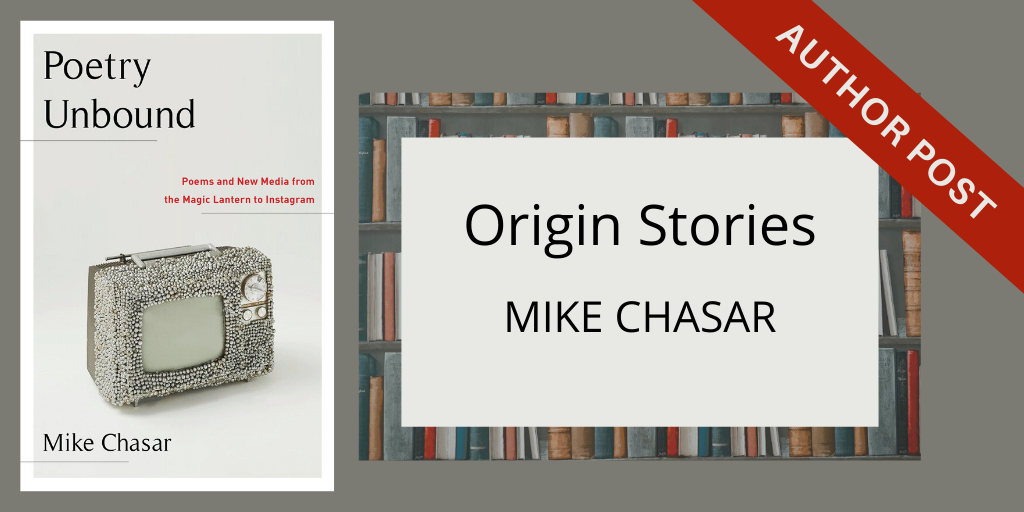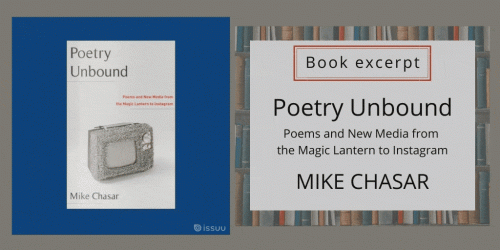Origin Stories
By Mike Chasar

“A persuasive, thoroughly researched, memorable, and often delightful book. Mike Chasar has excelled in his ambitious coverage of primary sources. Moreover, this is a book that addresses questions that come up frequently in the poetry world about where and why and how ‘poetry matters,’ and about its place in the wider culture.”
~Stephanie Burt, author of Don’t Read Poetry: A Book About How to Read Poems
We are continuing our celebration of National Poetry Month with a guest blog by Mike Chasar, author of Everyday Reading: Poetry and Popular Culture in Modern America and the recent Poetry Unbound: Poems and New Media from the Magic Lantern to Instagram. In this new work, Chasar follows poetry’s travels off the page into film, television, social media and more, presenting poetry’s evolving place in American culture. Chasar thinks back to how his study of poetry in new media began in today’s post.
Enter this week’s drawing for a chance to win a copy of the book!
• • • • • •
Every book has multiple origin stories, and Poetry Unbound is no exception.
One beginning of Poetry Unbound dates to the late 1980s when, in my late teens, I inherited from my maternal grandmother a copy of Edna St. Vincent Millay’s book-length poem The Murder of Lidice, which dramatizes the 1942 destruction of a Czechoslovakian town by Nazi forces. At the time, I didn’t know that Millay had been asked by the Writers’ War Board to write the poem as part of a multimedia propaganda campaign aimed at cultivating public support for U.S. intervention in World War II. I didn’t know that various versions of the poem would be printed in Life magazine and the Saturday Review of Literature. Nor did I know that it would be translated into multiple languages and performed by Hollywood actors for global radio broadcast by NBC in late 1942. What intrigued me back then was a newspaper clipping that my grandmother had sandwiched between the pages of her copy—a photograph showing the Nazi general responsible for carrying out the atrocity being hanged after the war. It took me almost twenty-five years to discover, study, and understand the significance of the poem’s multimedia history and, in so doing, also understand my grandmother’s private addition to her book and why she might have kept it among her possessions—the only poetry book she owned, I believe—for nearly fifty years.

I can trace another beginning of Poetry Unbound to the items pictured here—a set of TV trays sold or given away as promotional items by Motorola in the late 1950s or early 1960s. Finding them on eBay, I was immediately captivated by the image they conjured up of American Cold War audiences sitting in front of their Zenith TVs and putting their casseroles or sandwiches on top of the whimsical pictures and accompanying four-line verses like:
Clap your hands and lift your feet
And dance around to that solid beat
This real gone jive that lets you laugh
Sounds groovy too, on a phonograph.
and
This master piece will have to wait
Maybe until it’s quite too late
Cause who can deny that vibrant melody
Coming through the window with such fidelity.
Just a few years before these trays were produced, in 1950, the poet and critic Randall Jarrell had complained at Harvard University’s Defense of Poetry conference that most American readers were “unused to any poetry” at all, “even of the simplest kind.” Were these trays, I wondered, evidence to the contrary—and, if so, what type of evidence? What did it mean that Motorola gauged mac-and-cheese-eating fans of shows like Father Knows Best, I Love Lucy, and Gunsmoke to be interested in—or at least not turned off by—poetry? What counterintuitive or weird relationship between television and poetry was being forged in this most quotidian of places? Did TV—and, by extension, other nonprint media forms whose emergence so marked the twentieth century—have a closer or more complex relationship to poetry than I’d been led to believe by doomsayers and naysayers who’d long steered me toward books and away from TV, warning me of the harmful effect that TV would have on my reading and thinking skills and on the cultural status of poetry and literature and more generally?

In chapter 5 of Poetry Unbound, I study how popular and critically acclaimed TV shows incorporated, presented, and performed poetry throughout the duration of the Cold War—poems that audiences might have encountered while sitting in front of and reading or rereading the poems on Motorola’s trays. The trays, however, don’t make an appearance, so this posting is thus a kind of “outtake.” As I look at the trays now, however, I sort of feel like I am watching TV—or at least getting a simulated TV-watching experience. Their rounded corners and wood-grain veneer recall the rounded screens and wooden cabinets of Cold War–era televisions. In fact, the original box (pictured here) has a cut-out TV screen window through which one can view the top tray inside, suggesting that we are indeed encouraged to read the individual TV tray frames as the wooden cabinets or boxes of old televisions. By extension, we are also encouraged to imagine reading poetry on the TV screen—poetry on what would become known colloquially as the “idiot box.”
Today, these various boxes also make me think of what Henry Jenkins calls the “black box” fantasy of the modern media world—the dream that all media content might be routed through and coordinated by a single centralizing device. That’s exactly the sort of fantasy that these TV trays fuel. They reference the visual arts (the painter who pauses to listen to music coming from an adjacent apartment.) They reference live music. Their clever puns—the “fidelity” that evokes the “hi fidelity” of acoustic playback technologies and the “groovy” that connotes not just the vibe of the jazz scene but the material format of the phonograph record—reference acoustical media. And the text of the poems appearing on the “fine water- and alcohol-resistant lithographed paper” that Motorola uses to line the trays incorporates the history of print. In tying together visual art, music, recording technologies, and print, these trays’ accumulated boxes—the box of the individual tray, the box containing all four trays, and the box of the TV set—make a claim for TV’s unique power as a then-new “black box” technology capable of synthesizing and routing all media content through one device.

Having completed Poetry Unbound, I’m no longer surprised to see that poetry was used to narrate, facilitate, or underwrite TV’s effort to carve out a place as a new medium in the increasingly crowded media landscape of the long twentieth century. As the chapters of Poetry Unbound show, poetry helped the magic lantern refashion itself as a reading machine, thereby postponing its obsolescence in the early twentieth century and setting in motion a history of screen reading that we inherit today. Poetry helped in a variety of ways to broker the place of silent film and still helps sound film to do so. It works to similar effect in Father Knows Best, I Love Lucy, Gunsmoke, and hundreds of other TV shows from the Cold War forward, ranging from The Fresh Prince of Bel Air to Mad Men and Breaking Bad. And Instagram poetry is now having an unexpected effect on sales of poetry books, showing—as Millay’s poem from 1942 also showed—how the print and nonprint media formats of poetry’s distribution operate in more complex relationship to each other than we might expect.
If we privilege poetry as it appears in print contexts like books and little magazines, we risk overlooking this other, multimedia side of poetry’s history that has offered audiences new ways to experience poetry, that has shaped the history of the media we use on a daily basis, and that has shaped and reshaped poetry’s cultural power and standing—sometimes to the benefit of poetry, sometimes not. The history of poetry that most of us have been told has been a sort of shell game, one that Jarrell was playing at Harvard in 1950 when he said that American readers were “unused to any poetry” at all, “even of the simplest kind.” Indeed, like the cut-out window of the box containing Motorola’s trays, the prevailing view of poetry’s history in the long twentieth century has covered up much of the very object it charges itself with studying. Writing Poetry Unbound was like taking the trays out of that box and reading the poetry that’s been there—in one picture but out of another—all these years.




